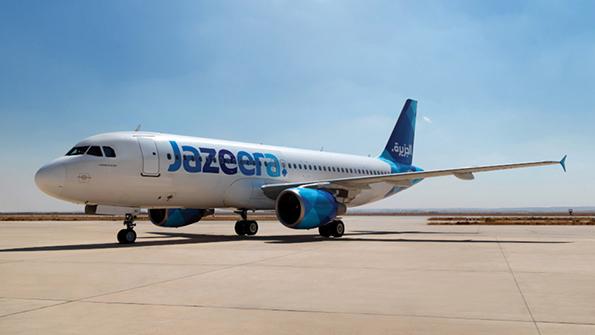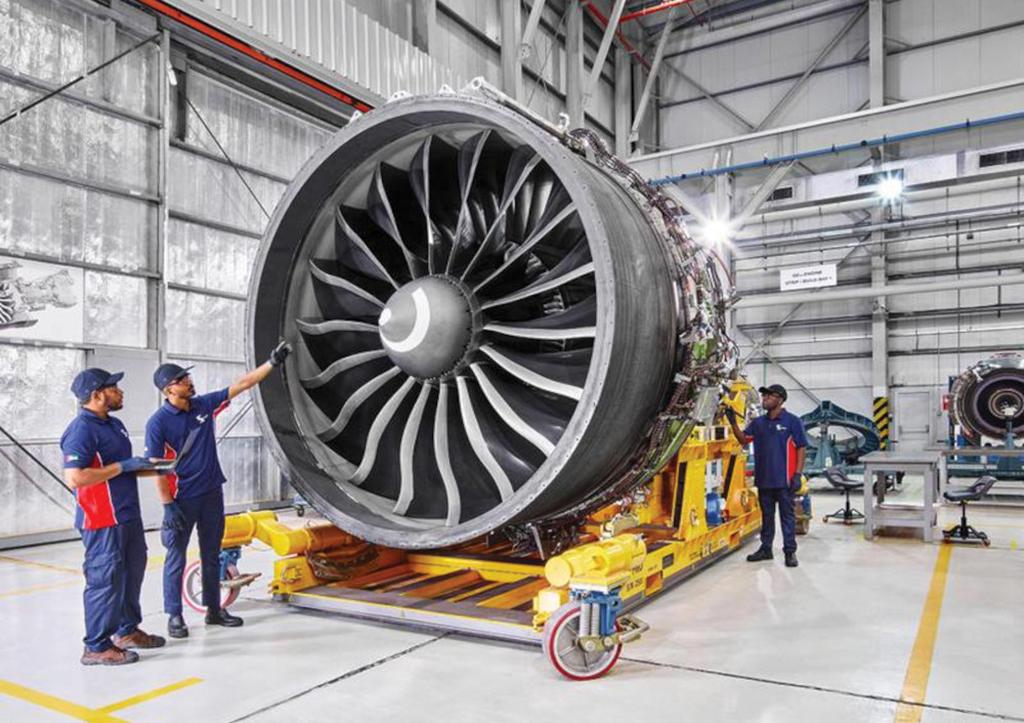
The mood was buoyant about the recovery prospects of a region severely challenged by the COVID-19 crisis at Aviation Week’s MRO Middle East event in Dubai in late February. As the event started, there was cause for greater optimism than at any time during the past two years. Passenger numbers in the Middle East have gradually risen over the past year with the lifting of some COVID-19 restrictions and stellar vaccination rates. The conference’s host location, the United Arab Emirates (UAE), surpassed a 96% fully vaccinated rate by early 2022.
However, long-term challenges fermented by the crisis loom large in areas such as workforce shortages and supply chain challenges. Russia invaded Ukraine during the week of the conference, and the steep rise in oil and gas prices due to Western sanctions on Russia are affecting aviation.
Last year’s market recovery should continue this year as a growing number of commercial aircraft have left storage and started flying to and from the region. This has led to increased maintenance demand. Aviation Week Network’s Commercial Fleet & MRO Forecast projects estimated maintenance spending of $108.1 billion this year.
Some MRO providers in the region had a good deal of work last year. “The signs of recovery started for us in January 2021, and we finished the previous year only 1% down on pre-pandemic levels,” says Frederic Dupont, vice president for technical sales and customer service at Etihad Engineering. This year has continued on the same trajectory, with the only surprise coming in January when the omicron variant resulted in a spike of new cases. “The good news was a lot of effort went into protecting our commitments for that month, but it did put a lot of stress on the operation, which temporarily led to people being away and resulted in a backlog,” Dupont says.
While Dupont is confident about Etihad’s year ahead, he identifies capacity as one of the company’s biggest challenges going forward. The carrier is looking to address this as it prepares for new work in areas such as the passenger-to-freighter conversion market with Israel Aerospace Industries (IAI) on Boeing 777-300ER aircraft this year, he says. “We were never going to undertake that work in our current facility, as this was supposed to be on top of existing work and not in lieu of it,” Dupont notes. Rather than building a new facility, he foresees Etihad Engineering seeking to occupy an existing space within the region.
Another MRO provider in the region buoyed by signs of recovery is Turkish Technic, which reported a revenue increase of 15.7% in March 2022 compared to the previous year. The company is looking to rebound to pre-pandemic levels by year-end, according to Chief Commercial Officer Yalcin Aydin. Participating on a panel at MRO Middle East, Aydin said the airline-affiliated MRO changed its five-year strategy because of the pandemic and targeted operational improvements such as cutting turnaround times, and reducing costs in areas such as contracts with an eye on better long-term profitability. It does not foresee capacity as an immediate challenge after adding a fourth MRO hangar in Istanbul in 2020. Since introducing base maintenance capabilities in 2021, it is now looking to grow third-party work outside of the Turkish Airlines fleet.

Intertwining Issues
Like much of the world, the current aftermarket landscape in the Middle East is seeing supply chain challenges related to both the shipping of materials and lead times around repairs. Jim O’Sullivan, vice president for business development at HEICO Aerospace, who oversees the PMA specialist’s operations in Europe, the Middle East and Africa, says it is a challenging time for the entire industry, including the supply chain.
He notes that since the company is a manufacturer as well as a designer and distributor of materials, “the supply chain is acutely very close to us in terms of raw material and the procurement of it as well as the logistics of shipping it around the world.”
Sergey Stolnikov, director of procurement and logistics at UAE-based maintenance provider VD Gulf, says problems that cropped up in the past two years will likely continue at least through this year and into 2023. “There’s a big deviation between our customers’ expectations of demand and our own,” he says. Over the next two years, he expects there will be a lot of emphasis placed on minimizing risks in the supply chain.
Robert Gill, group head for procurement and supply chain at Sanad Group, which focuses on engine services, says it has seen supply chain issues arise in recent years. “Material is of course needed for engine repairs, and maintenance and comes in different forms—either from the OEM or from a component removed from another engine and sent back,” he says. “Shipping challenges are common, but also lead times for the component repairs can be problematic.”
Gill says these challenges can differ by region. In the context of the Middle East, he says: “We are starting to feel demand picking up from airlines, and there is clearly an expectation from our customers to . . . jump from a capacity designed during COVID times back to a pre-COVID capacity—but this is extremely difficult to do.”
However, challenges pre-dating the crisis will remain, while the region’s MRO industry also faces new tests. Labor challenges unique to the Middle East are anticipated due to the region’s large expatriate workforce. At the height of the pandemic in 2020, maintenance providers saw many of their technical staff relocate to their homelands.
During the pandemic, a higher-than-normal number of employees has been either leaving or considering quitting their roles in search of new opportunities. The movement, dubbed “the great resignation,” has had an impact on the aviation industry as well. “There will be difficulties in finding inspectors, who are very specialized and specific to their roles,” Sanad’s Gill says.
Stolnikov of VD Gulf says the landscape for the labor market has already changed. “The availability of labor is much lower than it used to be, because the big players are trying to hire as much as possible, and this leaves less room for other companies.” HEICO’s O’Sullivan adds: “A huge amount of people in the supply chain and procurement areas have transferred their skills to other industries. Just trying to entice people back into the industry is proving a huge challenge.” O’Sullivan says he is seeing rising costs in contract labor, particularly at manufacturing facilities in the U.S.
Planning Ahead
After long-term fleet groundings, airlines are ramping up their operations, including in maintenance departments. Raghed Al Kaasamani, head of engineering at Kuwait-based Jazeera Airways, says the carrier has felt some of the effects of rising prices and cites as a recent example its attempt to ship a CFM56 engine from Singapore to Kuwait at a cost of $120,000. “Before, this didn’t exceed $15,000 to $20,000,” Al Kaasamani says.
The airline outsources most of its maintenance, and while it started doing its own line maintenance two years ago and hopes to soon have capability for light check work, Al Kaasamani does not see the dynamic changing. Jazeera also used the downtime to speed up the rollout of a new enterprise resource planning system in the form of Commsoft OASES. “This started in the fourth quarter of 2019, but when the pandemic started in 2020, we used the time to undergo training for the software and to fully implement the OASES platform across all the functions of department,” he says, adding that the challenge was that most of its implementation had to be done remotely due to lockdown restrictions. The project was finished after just nine months, a period Al Kaasamani notes would have taken considerably longer in normal times. “I believe that if there wasn’t the pandemic, this could have taken as long as 2-3 years,” he says.
New Capabilities and Tie-ups
Among the defining characteristics of the past decade has been the ambitious strategies adopted by Middle East-based MRO providers. This has led to a ramp-up of capabilities, particularly in the airframe and engine MRO segments. Despite the pandemic, this activity has continued at a steady pace over the past two years and continues in 2022.
VD Gulf, part of the Volga-Dnepr Group, received FAA maintenance certification for its facility in Sharjah, UAE, in December 2021, enabling it to provide MRO for U.S.-registered Boeing 737, 777 and 747-400 aircraft. However, that was announced before Russia’s invasion of Ukraine, and VD Gulf has yet to comment how the sanctions might affect these additions to its capabilities.
The Abu Dhabi-based Sanad Group is looking to grow beyond aviation MRO, an ambition highlighted by its recent signing of an agreement with Thales to collaborate on industrial services for airport security, air traffic and avionics systems. This has not distracted the company from some of its MRO goals, however. “In engine MRO, we are looking at used serviceable material, as that’s where you drive value for the end user,” says Mansoor Janahi, CEO of Sanad Group. “We’re not doing teardowns, but ultimately if the customer requires us to leverage one and drive further value, then absolutely.”
Another prominent trend for the region’s MRO sector has been more partnerships, particularly involving overseas MROs forming joint ventures with local partners. A new dimension of this has been in interregional partnerships. In the month following MRO Middle East, Bahrain-based carrier Gulf Air linked up with charter airline and MRO provider Texel Air to develop various cooperation opportunities, including charter agreements and engineering and maintenance activities.





